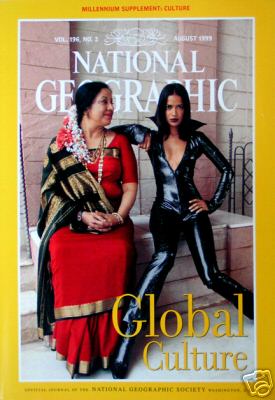Parameswaran (2002) writes:
The [National] Geographic’s August 1999 cover dramatically deploys women’s bodies as detailed blueprints, maps that busy readers could use to instantly trace the passage of non-Western cultures from tradition to global modernity…
More of her description of this cover after the image (found here):
An older middle-aged Indian woman, with streams of white and orange flowers pinned to her hair at the base of her neck, symbolizes tradition. The deep red silk sari with a gold border, the gold necklaces around her neck, and the thick gold bangles on her wrists clearly mark her as a traditional upper-class woman… The older Indian woman’s body and posture also announce her alignment with tradition. She is heavyset, almost stocky, and her sari demurely covers her large breasts. Her feet are placed moderately close together and her folded hands rest in her lap. Avoiding the direct eye of the camera, her face, with the trademark dot of the Hindu tradition etched between her eyes, is turned sideways as she bestows a tender maternal gaze on the young woman sitting beside her…
In contrast to the gentle passivity and the slack middle-aged body that index tradition, bold assertiveness, feminine youthfulness, and an androgynous firm body register cosmopolitan modernity in the cover of image. These biological and emotional transformations in the modern, non-Western woman’s physical appearance and personal demeanor appear to be wrought by Westernization. The young, slender Indian woman sitting next to the middle-aged woman has short, shoulder length hair framing her face. The marked absence of the dot on her forehead as well as her clothing, instantly herald her identity as a modern woman. She is dressed in a black, shiny PVC catsuit, unzipped down to the middle of her chest to display her small, almost flat breasts, while her feel are encased in sharply pointed black boots. Disdaining the gaze of the older woman directed towards her, she defiantly stares at the camera and claims her personal space with arrogant confidence. Her legs and felt, unlike the older woman’s feet, are splayed wide apart and her knees point in opposite directions. Her left arm is poised akimbo style while her left palm grips her hip in a strong masculine gesture.
In the magazines sharply polarized, binary rendering of the “new and hip” as radically different from the “old and outmoded,” one woman symbolizes ethnic tradition and the other global modernity…
Citation: Parameswaran, Radhika. 2002. Local Culture in Global Media: Excavating Colonial and Material Discourses in National Geographic. Community Theory 12, 3: 287-315.


Comments 4
Dubi — December 15, 2008
Yeah? So? Isn't that, like, the whole point of the picture?
Lazercat — December 15, 2008
This distinction is used to sell many beauty products in India, like skin-bleaching creams, weight loss and hair straightening.
A Western look is almost always associated with "modernity". The definition does not only include the rejection of any "ethnic"-looking clothing, it often includes European features, such as pale skin, straight hair and extreme thinness - characteristics that a lot of Indian women don't have naturally.
So many Indian women are getting the message that they are a hindrance to their country's progress, simply by being dark, curvy and wavy-haired, and by daring to be of a non-Western culture.
I'd go as far to say that, yes, colonialism is still alive and well today.
Esme — December 15, 2008
If memory serves (I recall analyzing this particular image in a class), the young woman in vinyl is actually the daughter of the older woman in more traditional garb. I don't know if that changes the message of the image, but context is always helpful.